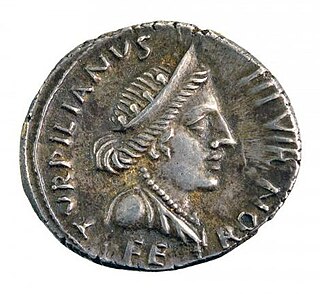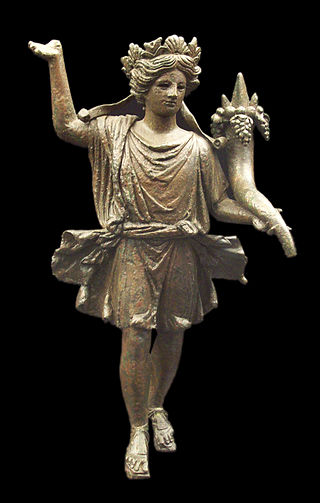
A dryad is a tree nymph or tree spirit in Greek mythology. Drys (δρῦς) signifies "oak" in Greek. Dryads were originally considered the nymphs of oak trees specifically, but the term has evolved towards tree nymphs in general. Often their life force was connected to the tree in which they resided and they were usually found in sacred groves of the gods. They were considered to be very shy creatures except around the goddess Artemis, who was known to be a friend to most nymphs.
Cardea or Carda was the ancient Roman goddess of the hinge, Roman doors being hung on pivot hinges. The Augustan poet Ovid conflates her with another archaic goddess named Carna, whose festival was celebrated on the Kalends of June and for whom he gives the alternative name Cranê or Cranea, a nymph. Ovid's conflation of the goddesses is likely to have been his poetic invention, but it has also been conjectured that Carna was a contracted form of Cardina, and at minimum Ovid was observing that their traditions were congruent.

In ancient Roman religion, the Manes or Di Manes are chthonic deities sometimes thought to represent souls of deceased loved ones. They were associated with the Lares, Lemures, Genii, and Di Penates as deities (di) that pertained to domestic, local, and personal cult. They belonged broadly to the category of di inferi, "those who dwell below," the undifferentiated collective of divine dead. The Manes were honored during the Parentalia and Feralia in February.

In ancient Roman religion, Strenua or Strenia was a goddess of the new year, purification, and wellbeing. She had a shrine (sacellum) and grove (lucus) at the top of the Via Sacra. Varro said she was a Sabine goddess. W.H. Roscher includes her among the indigitamenta, the lists of Roman deities maintained by priests to assure that the correct divinity was invoked in public rituals. The procession of the Argei began at her shrine.
A tutelary is a deity or a spirit who is a guardian, patron, or protector of a particular place, geographic feature, person, lineage, nation, culture, or occupation. The etymology of "tutelary" expresses the concept of safety and thus of guardianship.

Juno was an ancient Roman goddess, the protector and special counsellor of the state. She was equated to Hera, queen of the gods in Greek mythology and a goddess of love and marriage. A daughter of Saturn and Ops, she was the sister and wife of Jupiter and the mother of Mars, Vulcan, Bellona, Lucina and Juventas. Like Hera, her sacred animal was the peacock. Her Etruscan counterpart was Uni, and she was said to also watch over the women of Rome. As the patron goddess of Rome and the Roman Empire, Juno was called Regina ("Queen") and was a member of the Capitoline Triad, centered on the Capitoline Hill in Rome, and also including Jupiter, and Minerva, goddess of wisdom.

In Etruscan and Sabine religion, Feronia was a goddess associated with wildlife, fertility, health, and abundance, also venerated by the Faliscans and later adopted into ancient Roman religion. As the goddess who granted freedom to slaves or civil rights to the most humble part of society, she was especially honored among plebeians and freedmen. Her festival, the Feroniae, was November 13 during the Ludi Plebeii, in conjunction with Fortuna Primigenia; both were goddesses of Praeneste.

Maia, in ancient Greek religion and mythology, is one of the Pleiades and the mother of Hermes, one of the major Greek gods, by Zeus, the king of Olympus.

Egeria was a nymph attributed a legendary role in the early history of Rome as a divine consort and counselor of Numa Pompilius, the second king of Rome, to whom she imparted laws and rituals pertaining to ancient Roman religion. Her name is used as an eponym for a female advisor or counselor.

Lares were guardian deities in ancient Roman religion. Their origin is uncertain; they may have been hero-ancestors, guardians of the hearth, fields, boundaries, or fruitfulness, or an amalgam of these.

Oscilla is a word applied in Latin usage to small figures, most commonly masks or faces, which were hung up as offerings to various deities, either for propitiation or expiation, and in connection with festivals and other ceremonies. It is usually taken as the plural of oscillum, a little face. As the oscilla swung in the wind, oscillare came to mean to swing, hence in English oscillation, the act of swinging backwards and forwards, periodic motion to and fro, hence any variation or fluctuation, actual or figurative.

The Lapis Niger is an ancient shrine in the Roman Forum. Together with the associated Vulcanal it constitutes the only surviving remnants of the old Comitium, an early assembly area that preceded the Forum and is thought to derive from an archaic cult site of the 7th or 8th century BC.

In ancient Roman religion, a sacellum is a small shrine. The word is a diminutive from sacrum. The numerous sacella of ancient Rome included both shrines maintained on private properties by families, and public shrines. A sacellum might be square or round.

The Mother of the Lares has been identified with any of several minor Roman deities. She appears twice in the records of the Arval Brethren as Mater Larum, elsewhere as Mania and Larunda. Ovid calls her Lara, Muta and Tacita.

The vocabulary of ancient Roman religion was highly specialized. Its study affords important information about the religion, traditions and beliefs of the ancient Romans. This legacy is conspicuous in European cultural history in its influence on later juridical and religious vocabulary in Europe, particularly of the Christian Church. This glossary provides explanations of concepts as they were expressed in Latin pertaining to religious practices and beliefs, with links to articles on major topics such as priesthoods, forms of divination, and rituals.

The Lympha is an ancient Roman deity of fresh water. She is one of twelve agricultural deities listed by Varro as "leaders" (duces) of Roman farmers, because "without water all agriculture is dry and poor." The Lymphae are often connected to Fons, meaning "Source" or "Font," a god of fountains and wellheads. Lympha represents a "functional focus" of fresh water, according to Michael Lipka's conceptual approach to Roman deity, or more generally moisture.

In ancient Roman religion, the devotio was an extreme form of votum in which a Roman general vowed to sacrifice his own life in battle along with the enemy to chthonic gods in exchange for a victory. The most extended description of the ritual is given by the Augustan historian Livy, regarding the self-sacrifice of Decius Mus. The English word "devotion" derives from the Latin.

The Porta Querquetulana or Querquetularia was a gateway in the Servian Wall, named after the sacred grove of the Querquetulanae adjacent to and just within it. The grove appears not to have still existed in the latter 1st century BC.










